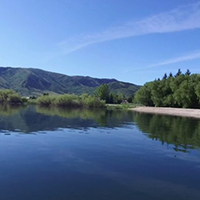Exploiting high frequency monitoring and satellite imagery for assessing chlorophyll-a dynamics in a shallow eutrophic lake

Submitted: 8 May 2021
Accepted: 15 June 2021
Published: 13 July 2021
Accepted: 15 June 2021
Abstract Views: 1393
PDF: 252
Supplementary 1: 48
Supplementary 2: 53
Supplementary 3: 52
HTML: 59
Supplementary 1: 48
Supplementary 2: 53
Supplementary 3: 52
HTML: 59
Publisher's note
All claims expressed in this article are solely those of the authors and do not necessarily represent those of their affiliated organizations, or those of the publisher, the editors and the reviewers. Any product that may be evaluated in this article or claim that may be made by its manufacturer is not guaranteed or endorsed by the publisher.
All claims expressed in this article are solely those of the authors and do not necessarily represent those of their affiliated organizations, or those of the publisher, the editors and the reviewers. Any product that may be evaluated in this article or claim that may be made by its manufacturer is not guaranteed or endorsed by the publisher.
Similar Articles
- Juha Merilä, Lakes and ponds as model systems to study parallel evolution , Journal of Limnology: Vol. 73 No. s1 (2014): Limnology in the 21st Century: celebrating 75 years of ecological research in Pallanza
- Diane M. Orihel, Rebecca C. Rooney, A field-based technique for sediment incubation experiments , Journal of Limnology: Vol. 71 No. 1 (2012)
- Esperança GACIA, Eglantine CHAPPUIS, Ana LUMBRERAS, Joan L. RIERA, Enric BALLESTEROS, Functional diversity of macrophyte communities within and between Pyrenean lakes , Journal of Limnology: Vol. 68 No. 1 (2009)
- Robin J. Smith, Dayou Zhai, Suktonthip Savatenalinton, Takahiro Kamiya, Na Yu, A review of rice field ostracods (Crustacea) with a checklist of species , Journal of Limnology: Vol. 77 No. 1 (2018)
- Oscar RAVERA, Gian Maria BEONE, Roberto CENCI, Paolo LODIGIANI, Metal concentrations in Unio pictorum mancus (Mollusca, Lamellibranchia) from of 12 Northern Italian lakes in relation to their trophic level , Journal of Limnology: Vol. 62 No. 2 (2003)
- Aldo MARCHETTO, Michela ROGORA, Measured and modelled trends in European mountain lakes: results of fifteen years of cooperative studies , Journal of Limnology: Vol. 63 No. 1 (2004)
- Finn Hirslund, An additional challenge of Lake Kivu in Central Africa - upward movement of the chemoclines , Journal of Limnology: Vol. 71 No. 1 (2012)
- Sergio Cohuo, Maria del Carmen Hernández, Liseth Pérez, Javier Alcocer, Candona alchichica (Podocopida: Candonidae), a new ostracod species from saline, tropical Lake Alchichica, Mexico , Journal of Limnology: Vol. 76 No. 1 (2017)
- Karina K. Tondato, Ibraim Fantin-Cruz, Olavo C. Pedrollo, Yzel R. Súarez, Spatial distribution of fish assemblages along environmental gradients in the temporary ponds of Northern Pantanal, Brazil , Journal of Limnology: Vol. 72 No. 1 (2013)
- Zhen Yang, Fanxiang Kong, Formation of large colonies: a defense mechanism of Microcystis aeruginosa under continuous grazing pressure by flagellate Ochromonas sp. , Journal of Limnology: Vol. 71 No. 1 (2012)
<< < 37 38 39 40 41 42 43 44 45 46 > >>
You may also start an advanced similarity search for this article.

 https://doi.org/10.4081/jlimnol.2021.2033
https://doi.org/10.4081/jlimnol.2021.2033






